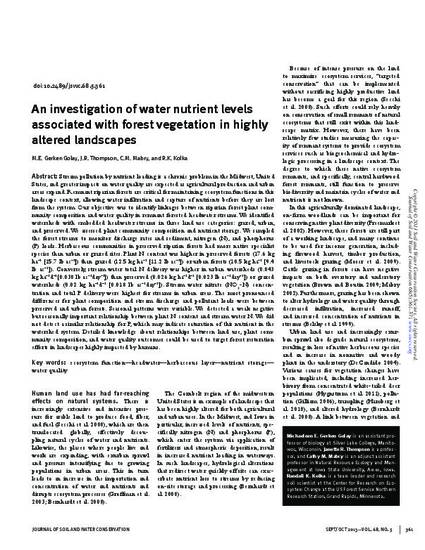
Stream pollution by nutrient loading is a chronic problem in the Midwest, United States, and greater impacts on water quality are expected as agricultural production and urban areas expand. Remnant riparian forests are critical for maintaining ecosystem functions in this landscape context, allowing water infiltration and capture of nutrients before they are lost from the system. Our objective was to identify linkages between riparian forest plant community composition and water quality in remnant forested headwater streams. We identified watersheds with embedded headwater streams in three land use categories: grazed, urban, and preserved. We assessed plant community composition and nutrient storage. We sampled the forest streams to monitor discharge rates and sediment, nitrogen (N), and phosphorus (P) loads. Herbaceous communities in preserved riparian forests had more native specialist species than urban or grazed sites. Plant N content was higher in preserved forests (17.6 kg ha−1 [15.7 lb ac−1]) than grazed (12.5 kg ha−1 [11.2 lb ac−1]) or urban forests (10.5 kg ha−1 [9.4 lb ac−1]). Conversely, stream water total N delivery was higher in urban watersheds (0.043 kg ha−1d−1[0.038 lb ac−1day−1]) than preserved (0.026 kg ha−1d−1 [0.023 lb ac−1day−1]) or grazed watersheds (0.02 kg ha−1d−1 [0.018 lb ac−1day−1]). Stream water nitrate (NO3-N) concentration and total P delivery were highest for streams in urban areas. The most pronounced differences for plant composition and stream discharge and pollutant loads were between preserved and urban forests. Seasonal patterns were variable. We detected a weak negative but seasonally important relationship between plant N content and stream water N. We did not detect a similar relationship for P, which may indicate saturation of this nutrient in the watershed system. Detailed knowledge about relationships between land use, plant community composition, and water quality outcomes could be used to target forest restoration efforts in landscapes highly impacted by humans.
Available at: http://works.bepress.com/catherine_mcmullen/2/

This article is from Journal of Soil and Water Conservation 68 (2013): 361–371, doi:10.2489/jswc.68.5.361.